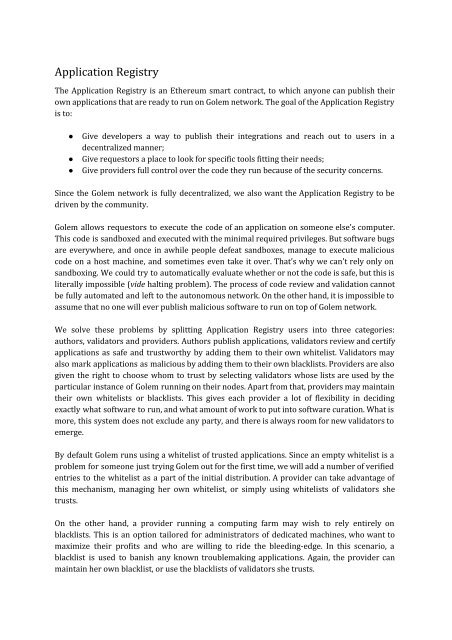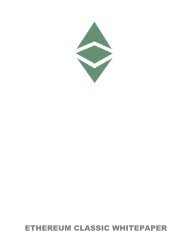whitepaper - golem with cover
Create successful ePaper yourself
Turn your PDF publications into a flip-book with our unique Google optimized e-Paper software.
Application Registry<br />
The Application Registry is an Ethereum smart contract, to which anyone can publish their<br />
own applications that are ready to run on Golem network. The goal of the Application Registry<br />
is to:<br />
●<br />
●<br />
●<br />
Give developers a way to publish their integrations and reach out to users in a<br />
decentralized manner;<br />
Give requestors a place to look for specific tools fitting their needs;<br />
Give providers full control over the code they run because of the security concerns.<br />
Since the Golem network is fully decentralized, we also want the Application Registry to be<br />
driven by the community.<br />
Golem allows requestors to execute the code of an application on someone else's computer.<br />
This code is sandboxed and executed <strong>with</strong> the minimal required privileges. But software bugs<br />
are everywhere, and once in awhile people defeat sandboxes, manage to execute malicious<br />
code on a host machine, and sometimes even take it over. That’s why we can't rely only on<br />
sandboxing. We could try to automatically evaluate whether or not the code is safe, but this is<br />
literally impossible (vide halting problem). The process of code review and validation cannot<br />
be fully automated and left to the autonomous network. On the other hand, it is impossible to<br />
assume that no one will ever publish malicious software to run on top of Golem network.<br />
We solve these problems by splitting Application Registry users into three categories:<br />
authors, validators and providers. Authors publish applications, validators review and certify<br />
applications as safe and trustworthy by adding them to their own whitelist. Validators may<br />
also mark applications as malicious by adding them to their own blacklists. Providers are also<br />
given the right to choose whom to trust by selecting validators whose lists are used by the<br />
particular instance of Golem running on their nodes. Apart from that, providers may maintain<br />
their own whitelists or blacklists. This gives each provider a lot of flexibility in deciding<br />
exactly what software to run, and what amount of work to put into software curation. What is<br />
more, this system does not exclude any party, and there is always room for new validators to<br />
emerge.<br />
By default Golem runs using a whitelist of trusted applications. Since an empty whitelist is a<br />
problem for someone just trying Golem out for the first time, we will add a number of verified<br />
entries to the whitelist as a part of the initial distribution. A provider can take advantage of<br />
this mechanism, managing her own whitelist, or simply using whitelists of validators she<br />
trusts.<br />
On the other hand, a provider running a computing farm may wish to rely entirely on<br />
blacklists. This is an option tailored for administrators of dedicated machines, who want to<br />
maximize their profits and who are willing to ride the bleeding-edge. In this scenario, a<br />
blacklist is used to banish any known troublemaking applications. Again, the provider can<br />
maintain her own blacklist, or use the blacklists of validators she trusts.
















